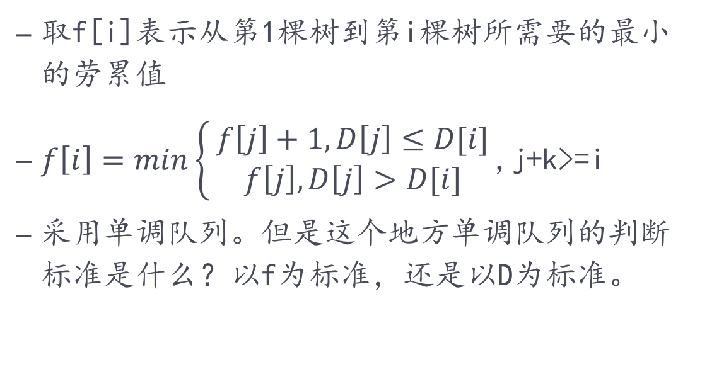单调队列应用--BZOJ 3831 Little Bird
2024-09-21 14:06:11
3831: [Poi2014]Little Bird
Time Limit: 20 Sec Memory Limit: 128 MB
Description
In the Byteotian Line Forest there are trees in a row. On top of the first one, there is a little bird who would like to fly over to the top of the last tree. Being in fact very little, the bird might lack the strength to fly there without any stop. If the bird is sitting on top of the tree no. , then in a single flight leg it can fly to any of the trees no.i+1,i+2…I+K, and then has to rest afterward.
Moreover, flying up is far harder to flying down. A flight leg is tiresome if it ends in a tree at least as high as the one where is started. Otherwise the flight leg is not tiresome.
The goal is to select the trees on which the little bird will land so that the overall flight is least tiresome, i.e., it has the minimum number of tiresome legs. We note that birds are social creatures, and our bird has a few bird-friends who would also like to get from the first tree to the last one. The stamina of all the birds varies, so the bird's friends may have different values of the parameter . Help all the birds, little and big!
有一排n棵树,第i棵树的高度是Di。
MHY要从第一棵树到第n棵树去找他的妹子玩。
如果MHY在第i棵树,那么他可以跳到第i+1,i+2,...,i+k棵树。
如果MHY跳到一棵不矮于当前树的树,那么他的劳累值会+1,否则不会。
为了有体力和妹子玩,MHY要最小化劳累值。
Input
There is a single integer N(2<=N<=1 000 000) in the first line of the standard input: the number of trees in the Byteotian Line Forest. The second line of input holds integers D1,D2…Dn(1<=Di<=10^9) separated by single spaces: Di is the height of the i-th tree.
The third line of the input holds a single integer Q(1<=Q<=25): the number of birds whose flights need to be planned. The following Q lines describe these birds: in the i-th of these lines, there is an integer Ki(1<=Ki<=N-1) specifying the i-th bird's stamina. In other words, the maximum number of trees that the i-th bird can pass before it has to rest is Ki-1.
Output
Your program should print exactly Q lines to the standard output. In the I-th line, it should specify the minimum number of tiresome flight legs of the i-th bird.
Sample Input
9
4 6 3 6 3 7 2 6 5
2
2
5
4 6 3 6 3 7 2 6 5
2
2
5
Sample Output
2
1
1
HINT
Explanation: The first bird may stop at the trees no. 1, 3, 5, 7, 8, 9. Its tiresome flight legs will be the one from the 3-rd tree to the 5-th one and from the 7-th to the 8-th.

单调队列中的元素主要考虑它的时效性和价值,时效性用来删除队头,价值和时效性综合考虑删除队尾。
单调队列中的时效性是越靠后(在队列中)越好,那么队列中元素的价值是:疲劳值和树高的综合考虑。
注意,如果对于两个位置j1和j2,有f[j1]<f[j2],则j1一定比j2更优。因为就算j1高度比较矮,到达i顶多再多消耗1个疲劳值,顶多和j2相等。如果不需要消耗疲劳值,比j2更优。 如果f[j1]=f[j2],则我们比较它们的高度D,高度高的更优。
#include<cstring>
#define N 1000050
#include<iostream>
using namespace std;
#include<cstdio>
int Q[N],head=,tail=,n,m,k,hig[N];
int f[N];
void input()
{
scanf("%d",&n);
for(int i=;i<=n;++i)
scanf("%d",&hig[i]);
}
bool cmp(int i,int j)
{
if(f[i]!=f[j]) return f[i]<f[j];
return hig[i]>=hig[j];
}
int main()
{
input();
scanf("%d",&m);
for(int i=;i<=m;++i)
{
scanf("%d",&k);
memset(Q,,sizeof(Q));
memset(f,,sizeof(f));
f[]=;head=;tail=;
Q[]=;
for(int j=;j<=n;++j)
{
while(head<tail&&j-Q[head]>k)
head++;
f[j]=f[Q[head]]+(hig[j]>=hig[Q[head]]);
while(head<tail&&cmp(j,Q[tail-]))
tail--;
Q[tail++]=j;
}
printf("%d\n",f[n]);
}
return ;
}
最新文章
- Android UI性能优化实战, 识别View中的性能问题
- HDU 4782 Beautiful Soup --模拟
- codeforce 626E(二分)
- (基础篇)PHP流程控制语句
- UVa 1646 (递推 JAVA大数) Edge Case
- angularJS的controller之间如何正确的通信
- .net中XML的创建01(传统方法)
- 仿猪八戒一个提示(jQuery插件) v0.1 beta
- 东软实训4-JDBC连接数据库
- Web模板
- OpenCV功能界面和示例
- UEP-自定义持久化类
- 分布式缓存组件Hazelcast
- 四大组件之Activity小结
- vagrant命令
- 20175206迭代与JDB测试
- 切换目录查询目录 tcp
- Confluence 6 启用和禁用 Office 连接器
- 使用cxf两个声明导致ObjectFactory 类中发生冲突
- HDU1208:Pascal's Travels(DP)